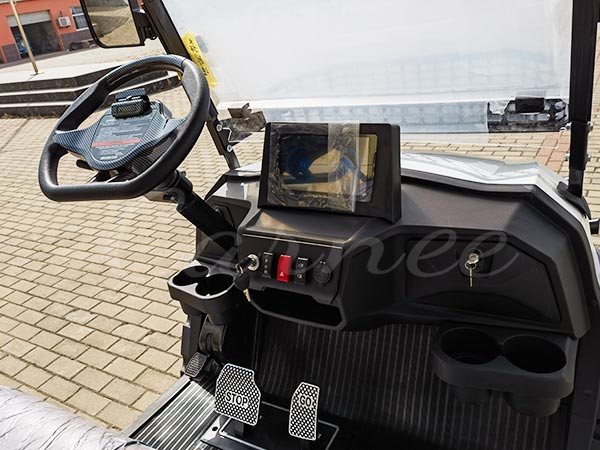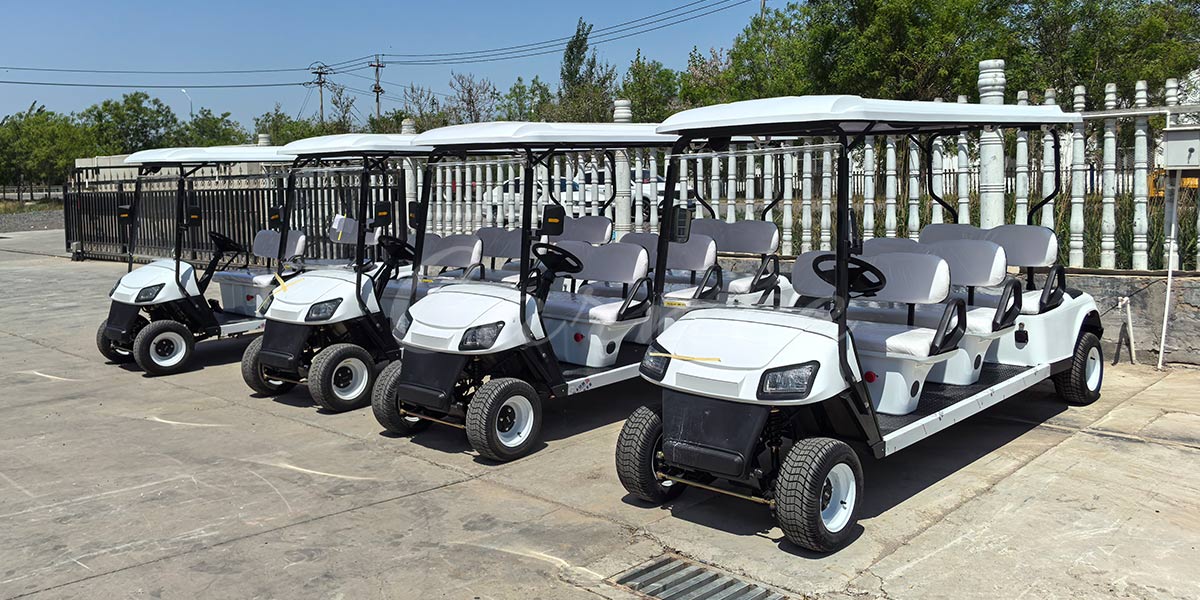Curious about how does an electric golf cart work? As a manufacturer with over 20 years of experience, we understand why electric golf carts are quickly replacing gas models on golf courses, in resorts, communities, airports, and industry. In this guide, you’ll learn how electric golf carts operate, their main components, advantages, types, and applications—plus essential maintenance and buying advice.

An electric golf cart is a compact, battery-powered vehicle designed for reliable, quiet, and eco-friendly transportation over short distances. Unlike gas operated golf carts, electric models use rechargeable batteries and an electric motor, making them quieter, easier to maintain, and environmentally friendly.
Electric golf carts come in a range of types, including two-seat and four-seat carts, utility and work carts, small golf cars for tight spaces, and remote control electric golf caddy models. They’re used far beyond the golf course—think resorts, hotels, airports, hospitals, industrial parks, campuses, and private estates. Thanks to their versatility, you’ll find electric golf carts serving as people movers, cargo carriers, maintenance vehicles, and even event shuttles.
Want to know more about standard sizes for different applications? See our in-depth guide:
Standard Golf Cart Dimensions: Everything You Need to Know
The performance and reliability of electric golf carts come from a carefully engineered system where each component plays a crucial role:
Electric golf carts rely on high-capacity batteries—either deep-cycle lead-acid or advanced lithium-ion. Batteries store the energy needed to power the cart. Modern lithium-ion options provide lighter weight, faster charging, and longer lifespan.
The electric motor converts electrical energy from the battery into mechanical power to drive the wheels. Some carts use efficient AC motors, others use DC motors. The motor controller acts as the cart’s “brain,” precisely managing the electricity flow for smooth starts, safe acceleration, and effective speed control.
Want to know about frames and strength? Read:
Electric Golf Cart Chassis and Frame: Your Guide to Smarter, Stronger Carts
Charging is simple: plug your cart into a compatible charger. Most models feature onboard chargers, making it easy to recharge at home or on-site. Proper wiring and a reliable charging system are vital for performance and safety.
Acceleration: Step on the pedal to send power from the batteries to the motor.
Regenerative Braking: Many carts recover energy during braking, sending it back to the batteries.
Direction Control: Use a selector to go forward or reverse. Advanced models may feature speed governors for safety.
Electric golf carts can be equipped with lights, seat belts, remote control features, GPS, music systems, and specialized suspensions for work or rough terrain, making them suitable for any environment.


Eco-Friendly: No exhaust, zero emissions, and low environmental impact.
Quiet Operation: Minimal noise, perfect for communities, resorts, hospitals, and events.
Low Maintenance: Fewer moving parts than gas models, with no oil changes or spark plugs required.
Cost Savings: Electricity is more affordable than gasoline; less frequent repairs save money long-term.
Smooth Power & Instant Torque: Quick, comfortable starts and easy maneuvering in tight spaces.
Versatility: From golf courses to factories, electric golf carts are used for transport, logistics, and recreation.
Need to move or export a cart? See:
Golf Cart Shipping & Packaging Guide: Safe and Efficient Export Solutions
Electric golf carts use battery power and an electric motor, are quieter, and require less maintenance.
Gas powered golf carts run on gasoline engines, may offer longer range, but are noisier and produce emissions.
Electric models are ideal for indoor, residential, or environmentally sensitive areas, while gas models may be suited for some rugged outdoor applications.
Cart won’t start: Check battery charge and connections.
Weak acceleration: Inspect battery voltage and controller.
Strange noises: Check the motor and frame for wear.
How to start: Insert the key, check the charge, select the direction, and press the pedal.
Charge after each use; avoid deep discharges.
For lead-acid batteries, regularly check fluid levels.
Keep terminals clean and wiring in good condition.
Inspect the controller and motor for signs of wear.


Battery Type: Lithium-ion for long life and fast charging, lead-acid for affordability.
Seating & Size: 2, 4, or more seats for your needs.
Power: Standard, heavy-duty, or high-performance motors.
Intended Use: Golf, utility, industrial, or personal transportation.
Features: Lighting, weather protection, GPS, music, or cargo upgrades.
Support: Choose a manufacturer with reliable service, OEM options, and a strong warranty.
With 20+ years of manufacturing experience, we provide expert guidance and custom electric golf cart solutions for every application.

How do you start an electric golf cart?
Insert the key, turn on the power, select forward or reverse, and press the pedal.
What batteries are used in electric golf carts?
Most use deep-cycle lead-acid or lithium-ion batteries.
How much horsepower does an electric golf cart have?
Typically, between 3 and 7 horsepower, depending on the model.
How long does charging take?
Charging usually takes 4–8 hours, depending on battery type and charger.
Understanding how does an electric golf cart work is essential for making an informed purchase. Electric golf carts offer quiet, efficient, and eco-friendly performance for golf courses, businesses, communities, and private owners. With the right model, you’ll enjoy low operating costs, easy maintenance, and outstanding versatility.
Ready to upgrade or purchase an electric golf cart? Contact us today for expert advice and solutions from a trusted manufacturer with over 20 years of experience.

Please contact us for free quotation by form below. We promise the quickest response within 24 hours: